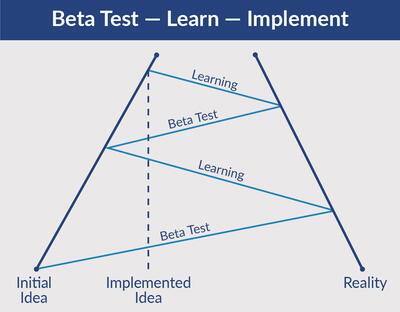
How does local government implement most things? Unfortunately, we come up with a new idea or a significant improvement—whether in a program, policy, regulation, or design—and proceed with an organization-wide or community-wide implementation. We often don’t test our ideas to see if they work or can be improved. This approach is completely wrong and adds to our risk averse culture. I strongly recommend that you stop this old approach to implementation and instead use beta testing.
What Is Beta Testing?
Originally, this term was applied to the second phase of testing computer code. It was expanded to testing computer programs, systems, or computer applications. Over time, this term has come to refer to the testing of almost anything—ideas, programs, policies, regulations, marketing strategies, or designs. Beta testing can be synonymous with the terms pilot or experimental program.
Beta testing is a smart, logical, and efficient way to implement new programs or significant changes. It is simply taking a new idea or change and testing it in the marketplace, whether the marketplace is within an organization or within the community.
Beta testing isn’t complicated and can be used at any level of an organization. A city council, city manager, department head, or anyone who comes up with a new idea for significant change or improvement should beta test it. I don’t care how good the idea is or sounds, the first step is to test the idea.
What I Learned from the Private Sector
After retirement, I went to work for a private sector start-up. I was one of the first 20 employees and we were trying to figure out the most effective and useful way for neighbors to connect with each other through a mobile application. We were also trying to figure out how to get local governments to use the app as a way to keep neighbors informed. I wish I had known as a city manager what I learned at Nextdoor.
Nextdoor beta tested almost everything, including different visual formats, application menus, marketing strategies, and connection tools. Nextdoor had lots of smart people with lots of ideas, but all ideas had to prove themselves in the market. We sometimes killed ideas after testing them or we learned how to improve them before rolling them out to every neighborhood. We were driven by real world feedback.
Why Should Local Government Mimic the Private Sector?
There is a lot wrong with the private sector’s lack of ethics and its myopic focus on making the greatest profits; however, there are some things we can learn from the private sector. Beta Testing is one of them.
Unfortunately, local government is very risk averse. Beta testing allows an organization to do a small test of an idea, program, or regulation without:
• Taking a big risk.
• Putting up major money.
• Committing to a particular change.
• Deciding to recommend a program/change to the city manager or city council.
Beta testing grants organizations the opportunity to try new ideas, programs, policies, regulations, or designs without the council, city manager, or department head having to risk a possible large failure.
We in local government try hard to come up with good ideas; however, we fall in love with our good ideas and implement them organization-wide. Several different things can then happen:
1. Our brilliant idea is a failure, and we have the embarrassment and ego-crushing experience of having to cancel something that has been implemented systemwide.
2. Our idea is good, but we realize there are necessary changes, which cause headaches and heartaches when we must make systemwide changes.
3. We realize that our idea could have been better, but our ego or bureaucratic rigidity prevents us from making necessary improvements. We then settle for a mediocre program or policy.
Implementing a program or plan without knowing how well it will work is arrogant and reckless. No matter how smart people are, there is no way to know how something will work until it is tested.
Figure 1 is a visual presentation of the beta test process.

Simple Beta Test Steps
There is no one way to beta test. You can experiment, but the following are some useful guidelines.
1. Be clear about what you propose to change and why.
2. Set up a predetermined time frame to test your idea.
3. Establish straightforward metrics for evaluation. Qualitative input is as important as quantitative data.
4. Test your idea. If it is a change in an organization, test it in a subsection of the organization. If it is a change in the community, test it within a small neighborhood.
5. Test your idea with a subgroup that will be open to the experimentation.
6. Obtain feedback from the beta test and apply your predetermined metrics to determine the efficacy of your pilot.
7. If the feedback is promising, try a larger test to work out any additional bugs. If that is not possible, learn from the first test, improve the program, and then implement it organization-wide.
8. If the feedback is negative, decide whether to do a major revision or just kill the idea.
Not all ideas will pass the beta test. You are trying to be innovative without the risk of a big failure.
Beta Test = Pilot or Experiment
It is very difficult to make necessary changes or implement new programs without significant resistance inherent in our risk averse environment. So, never again implement a new program or policy without a beta test. Title your beta test a “pilot” or “experiment.”
The naysayers, idea killers, and negative employees or bosses in your organization don’t have the time or energy to worry about every pilot program. Usually, your pilot program will fly under the radar. If someone raises issues, your best response is to say that it is just a pilot or an experiment and it may or may not work.
If the idea is bad, the pilot program quietly goes away. If the idea is good, then the group that beta-tested/piloted the idea will become your new advocates. If you “pilot” a second time with a larger group, you will develop more supporters prior to full implementation.
Where To Start?
Start anywhere, but start small. Help your organization learn how to beta test and then expand its use.
Beta test a new performance evaluation system that focuses on employee development (see last month’s article). Beta test a change in policy, a new street design, a zoning regulation change, a new budgeting process, a parking ordinance, or new operating hours.
An upcoming article in this series will describe a pilot program that is beta testing a different way to think about and respond to certain types of calls for service.
Closing Comments
It takes arrogance, hubris, or stubbornness to believe that one’s untested ideas must be brilliant and hence immediately implemented organization- or community-wide. It takes thoughtfulness, humility, and patience to test one’s ideas in the marketplace.
A wise person once told me to “go slow to go fast.” I am impatient and it took time for me to understand the wisdom of this saying. Too often, we rush to implement new ideas; however, our initial idea is never the best version of the idea. If we go slow, test our ideas, and learn how to improve them, then we will have a smoother, successful, and faster system-wide implementation.
So, go forth. Test, pilot, and experiment. Make significant changes without as much resistance and negativity. Try it, you will like it…innovation without hesitation, heartaches, or disasters. I will freely consult with anyone trying a beta test for the first time.

ED EVERETT, ICMA-CM (RETIRED), is a retired city manager (everetted@comcast.net).
New, Reduced Membership Dues
A new, reduced dues rate is available for CAOs/ACAOs, along with additional discounts for those in smaller communities, has been implemented. Learn more and be sure to join or renew today!
